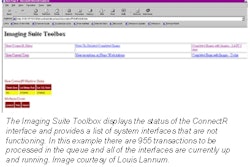SALT LAKE CITY - The economic advantages of application service provider (ASP) models for PACS users have been thought to be the primary lure. But according to a survey of several ASP sites, protection against technology obsolescence and guaranteed service/uptime were even more important factors for choosing the ASP approach.
Despite the hype surrounding ASP models for PACS, fewer than 1% of all digital image management sites currently use the ASP approach, according to John Strauss, a SCAR marketing consultant.
"Confusion, the immaturity of the ASP marketplace, and lack of published data serve as impediments to prospective ASP customers," he said.
To learn from the experience of existing ASP users, the research team contacted four vendors (eMed Technologies, Siemens Medical Solutions, InSite One, and Wam!Net), to obtain contacts for an ASP client survey. Strauss presented the study team's findings during a SCAR University session today.
The four survey respondents asked to remain anonymous. Case study 1 was a university teaching hospital in the southern U.S. with annual exam volume of more than 110,000 exams. The facility had an enterprise-wide PACS with an HIS/RIS interface, and chose an ASP approach for a data/image repository, enterprise patient scheduling, and telemedicine.
The hospital chose an ASP model hoping to improve workflow, speed image retrieval times, and maximize uptime, Strauss said. The ASP model was determined to be more cost-effective than a capital purchasing approach (using a return on investment model and estimating dollars needed for anticipated growth).
The institution pays 23 cents per MB, although it has flexible pricing based on exam/volume size and changes in storage costs. Through the six months of the ASP relationship, the site reported that it is extremely satisfied with its implementation and very happy with its vendor.
Case study 2 was a community hospital in the northeast U.S., generating annual exam volume of 130,000 exams per year. The institution had a HIS/RIS in place, with a PACS implementation in transition.
The hospital is using data/image repository and virtual private network (VPN) services from its ASP vendor. It chose an ASP approach to secure technology obsolescence protection, and shift operational responsibility to the vendor. Operational cost savings and a lack of up-front capital were also factors in the decision. The ASP vendor had chosen the hospital as a development partner.
Financial analysis was performed using an ROI model and calculating total cost of ownership (TCO). Interestingly, the analysis, conducted by an outside consultant, found the ASP model to be less cost-effective than a traditional PACS acquisition approach.
The site is satisfied without reservations, although not sure if it would go the ASP route again, and is undecided about its current plans following the conclusion of the one-year contract.
Case study 3 was a large, for-profit outpatient imaging network in the western U.S. that produces 600,000 annual exams. Prior to use of the ASP, the network had a RIS with a miniPACS network. The network chose the ASP model for a data/image repository, Web-based image distribution, enterprise patient scheduling, Web security, and marketing and consulting services.
The ASP approach was chosen to reduce long-term debt, provide rapid deployment of the technology, and secure obsolescence protection. Financial analysis of the ASP approach was performed using ROI and TCO models. Performed by the director of IT, the analysis concluded that the ASP model was more cost-effective than a purchase or lease.
The network is currently paying $2.10 per study, although future pricing is flexible based on changes in exam volume and/or expanded capacity. Since it is a new implementation, the site was unable to assess vendor performance and customer satisfaction.
"It's too early to tell, but they seem to be pretty pleased," Strauss said.
Case study 4 was a U.S. government agency with annual exam volume of 200,000 studies. The institution had a RIS with a miniPACS, and selected an ASP approach for its data/image repository, Web-based image distribution, telemedicine, and Web security/VPN.
TCO analysis was performed by the CEO, which found the ASP model to be more expensive over the long term, but less capital-intensive. The facility is paying a fixed monthly fee based on expected storage requirements. The fee can be increased if storage capability exceeds a ceiling figure. After 2 1/2 years of ASP use, the facility is very satisfied with its vendor.
Asked to rate the decision criteria behind its decision to go with the ASP model on a scale of 1-5 (1 not important, 5 extremely important), the four sites ranked protection against technology obsolescence and guaranteed service/uptime as an average of 5.
Ranked slightly behind those two factors at 4.75 were economics, defined implementation planning, and scalability. Redundancy and open standard support were ranked slightly lower at a mean of 4.5.
Least important to the customers were business modeling and consulting services, coming in at 2.75.
In summary, factors behind the choice of the ASP model were: lack of upfront capital requirements, technology obsolescence protection, speed of transition, shift of operational issues to vendors, and operational cost savings relative to film.
When choosing an ASP model, healthcare institutions should be sure to customize the financing strategy to the needs, resources, and risk aversion of the institution, Strauss said. In addition, some customers are choosing an ASP approach for reasons other than economics alone, including technology obsolescence protection, service/uptime guarantee, and speed of transition.
"There still isn't a real clear path that the ASP approach is a strong one for everyone," he said. "As the marketplace matures, more information and experience will be made available to assist prospective customers in their decision making. The operational and financial success or failure of ASPs will be largely determined by the experiences of early ASP adopters."
By Erik L. RidleyAuntMinnie.com staff writer
May 4, 2001
To view the rest of AuntMinnie's coverage of the SCAR meeting, just go to our RADCast@SCAR 2001 at http://scar.auntminnie.com.
Click here to post your comments about this story in our PACS Digital Community. Please include the headline of the article in your message.
Copyright © 2001 AuntMinnie.com




















